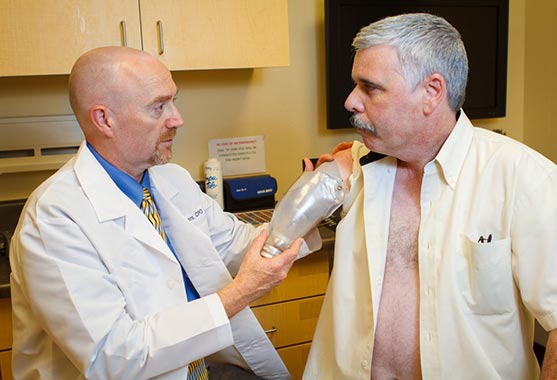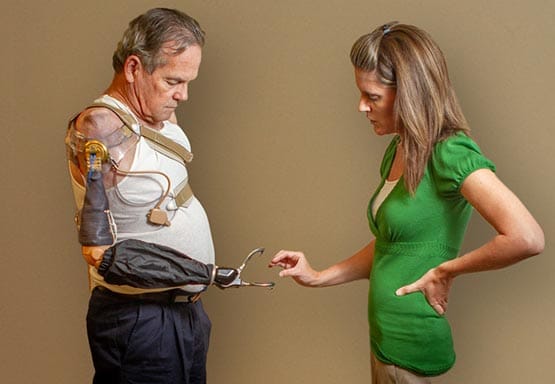Updated 03/2019 | Originally from inMotion, Volume 21, Issue 1 January/February 2011
Introduction
Your life has changed – you’ve lost an arm. Now what? What will you be able to do? How will others see you? Will life ever be “normal” again? While it is over- whelming to face so many unknowns, be reassured that there are many people and organizations that can help guide you and your family along the path of recovery and rehabilitation. Over the next 12 months, your life is likely to include several recurring themes: medical care, emotional challenges, prosthetic care, and occupational and physical therapy.
Medical Care
The starting point for your rehabilitation is medical care. A few days after surgery, your medical care transitions from suture and staple removal to wound care and pain management. Once you leave the hospital, you will become more responsible for monitoring the physical aspects of your recovery and reporting this to your doctor at regular follow-up visits. At some point during the first 3 months, your surgeon will probably transition your care to a physical medicine and rehabilitation (PM&R) physician, or physiatrist. The PM&R physician focuses on pain management and medications and is your main referral source for emotional healthcare, prosthetic treatment, occupational and physical therapy, social services and return-to-work issues. Your relationship with this physician will likely continue throughout your life, so take the time to build a good rapport. The other professionals who become part of your care team will work closely with this physician to manage your rehabilitation. While you are the central decision-maker on your team, the PM&R physician is the director that gets you the services you need.
Emotional Challenges

Good communication between the upper-limb patient and the prosthetist is essential to becoming a successful prosthesis user.
Limb loss has a significant emotional impact on both the individual and his or her family. It is important to understand the range and intensity of feelings you may experience during the first 12 months, and perhaps longer. Many people overlook or avoid the opportunity to talk with a counselor and address the reality of the grieving process. Emotional recovery is a highly personal experience with no set timeframe. Some people feel that they quickly reach a level of acceptance following their injury or surgery, 24 only to find themselves pulled back into feelings of grief when they least expect it. Establishing a comfortable, honest dialogue with a licensed counselor, social worker, psychologist or support group should occur within the first 3 months of your recovery.
Prosthetic Care
Most new amputees are referred to a prosthetist after their surgical sutures or staples have been removed. In some hospitals, an immediate post-operative prosthesis (IPOP) is applied by a prosthetist in the operating room so that from the moment a person awakens from amputation surgery, he or she is wearing a prosthesis. In either case, it is important to understand that you will probably be working with a prosthetist for the rest of your life. To get the best possible outcome, be sure the prosthetist you choose has extensive upper-limb experience.

Upper-limb patients will work closely with an occupational therapist to learn to use their prosthesis.
In one of your earliest meetings with a prosthetist, while your residual limb is healing and creating new circulation pathways, you may be fit with a “shrinker” that is made from fabric or silicone. It looks like a sock but its function is to help reduce swelling in the residual limb, compress the tissue and build tolerance to pressure. Even after you begin wearing a preparatory prosthesis, you will continue to use a shrinker during the first year when you’re not wearing a prosthesis.
The first month of your recovery is often when you learn the most about integrating a prosthesis into your life, before you get used to doing things without a prosthesis. The prosthetist you select will spend a significant amount of time discussing your goals, learning about your history, and teaching you about prosthetic options and components. It is vital to establish open communication and trust with your prosthetist. Help him or her understand your life by discussing your work, family and recreational activities.
Occupational or Physical Therapy
An occupational or physical therapist will play a key role in guiding your rehabilitation. The therapist and the prosthetist work together to create a treatment plan that moves you through the three phases of therapy: pre-prosthetic, interimprosthetic and post-prosthetic. During the first month, the focus is on preparing you to wear a prosthesis. In the second or third month you begin learning to use a preparatory prosthesis and work on repetitive drills and controls training. More complex tasks are added after you receive your final prosthesis and are moving toward the 12-month mark.
Building a positive working relationship with your therapist gives you a secure place to practice both new and familiar tasks before trying them in the real world. This will help build confidence with your body and with the use of your prosthesis. Let your therapist know the goals you have for your recovery and stay openminded about trying different exercises and prosthetic components to accomplish your goals. After the first 12 months of therapy have been completed, it is important to remember that you can revisit therapy later, when you try new activities or prosthetic components.
One year after losing your arm, you will have learned a great deal about adjusting to life as an amputee and a prosthesis user. You will have discovered new ways to approach both simple and complicated tasks. And, most importantly, you will have a team of supportive people – professionals, family and friends – that will continue to help you set and reach new goals in your rehabilitation.
Photos courtesy of Arm Dynamics
It is not the intention of the Amputee Coalition to provide specific medical or legal advice but rather to provide consumers with information to better understand their health and healthcare issues. The Amputee Coalition does not endorse any specific treatment, technology, company, service or device. Consumers are urged to consult with their healthcare providers for specific medical advice or before making any purchasing decisions involving their care. © Amputee Coalition. Local reproduction for use by Amputee Coalition constituents is permitted as long as this copyright information is included. Organizations or individuals wishing to reprint this article in other publications, including other websites must contact the Amputee Coalition for permission to do so, by emailing a request to rc@amputee-coalition.org.



